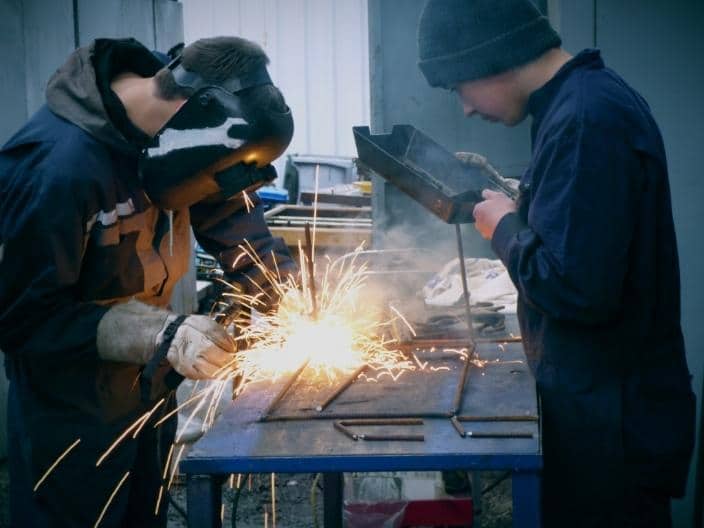If you have considered a career in welding, you know that the job requires a particular set of skills and knowledge base. This exciting and lucrative field is always in demand. All you need is a practical education and some hands-on training, which you can receive by attending one of the many high-quality welding schools throughout the country.
Many colleges and universities with career training programs offer welding programs. The community college system is an excellent resource for affordable training in many states. Some states even have career paths that prepare students for an entry-level job upon graduation. Additionally, internships and apprenticeships through top welding schools can help students gain the on-the-job experience needed to thrive in the workplace.
What To Expect from Welding Schools Nationwide
Each welding school will have a unique curriculum. In many cases, this is tailored to local needs. For example, welding schools near the Gulf of Mexico may offer programs geared toward oil refineries, while programs in the upper Midwest may be more geared toward the automotive industry. Despite their differences, virtually all welder training programs cover a wide range of topics, including:
- Identifying different metals and the best ways to work with them
- Reading blueprints and construction drawings
- Basic construction-related math (geometry, trigonometry, algebra, etc.)
- Proper safety precautions for welding
- Inspection and quality control of welds
- Various welding techniques, such as:
- Flux-Cored arc welding
- Shielded metal arc welding
- Gas tungsten arc welding
- Gas metal arc welding
Many welding schools also prepare students to sit for national certification exams, such as those offered by the American Welding Society. This can help advance your career since many companies prefer to hire welders with AWS certifications.
Welder Training and Career Opportunities by State
Click on the appropriate state name to learn more about possible welding careers in your area and some of the training programs that can help prepare you for them.
- Alabama: Welders in Alabama often find jobs in shipyards, power plants, or manufacturing. Several community colleges offer certificates and degrees in welding, and the Alabama Pipe Welders Academy in Mobile offers a 16-week career training program to get you in the workforce quickly.
- Alaska: Welders in Alaska are some of the highest-paid in the nation, with numerous opportunities to work in power plants and on infrastructure projects. Schools like the University of Alaska and the Industrial Training Center can prepare you for a welding career in as little as four weeks.
- Arizona: Welders in Arizona are frequently employed in manufacturing, although certain projects require a contractor license with a welding classification. Training is available at community colleges.
- Arkansas: Many Arkansas welders work in the manufacturing industry, earning an average of $39,750. Training programs are available at public and private schools and can take a few months to three years.
- California: Welders in California can earn wages above the national average working in construction and the energy industry, but they must be licensed by the state contractor board. In-state training can take between nine months and three years to complete.
- Colorado: Colorado welders often find work in the construction and manufacturing industries. Many state community colleges offer AAS in Welding Technology, while the certificate program at Emily Griffith Technical College prepares you for a career in about a year.
- Connecticut: Welders in Connecticut often work in construction, offshore operations, or manufacturing, although certain fields require a state license. There are excellent, affordable welding schools in the state, including at least one free high school career preparation program.
- Delaware: Delaware offers myriad career opportunities for welders, many of them centered around marine industries. Many welders earn up to $20 per hour after completing one of the accelerated training programs in the state.
- Florida: Welders in Florida have various careers to choose from, including shipbuilding, construction, and building and maintaining amusement park features. Training programs generally range from seven to 18 months.
- Georgia: Georgia is home to robust manufacturing and film industries, which frequently require qualified welders. After completing training, you can expect to earn between $22,000 and $34,000 as an entry-level welder.
- Hawaii: Shipbuilding, manufacturing, and equipment maintenance are popular career paths for welders in Hawaii. Community colleges offer welder training programs, after which you must obtain a state welder license.
- Idaho: Welders in Idaho often find rewarding careers in the construction and engineering industries. Several public colleges in the state offer affordable tuition on welder training programs.
- Illinois: Automotive and manufacturers and construction are the top industries for Illinois welders, who can expect to earn an average of $19.50 upon entering the workforce. Training programs take between one and two years, and there are several affordable options for state residents.
- Indiana: Manufacturing, aerospace, and defense are top industries for welders in Indiana. There are numerous certificate, degree, and apprenticeship programs available in the state to prepare you for a career.
- Iowa: May welders in Iowa find work in the agricultural industry, particularly building and servicing agricultural equipment. Welder training programs are available at many public and private schools.
- Kansas: Kansas also offers many agricultural-linked employment opportunities, with the average entry-level welder salary in the state of just over $40,000. You can obtain a career certificate in as little as nine months at several Kansas welding schools.
- Kentucky: Kentucky offers welders ample opportunities to work in manufacturing and construction-related industries. Several accelerated training programs can prepare you for a career in as little as eight weeks.
- Louisiana: Options for entry-level welders in Louisiana include the aerospace, construction, and energy industries, with an average salary of around $23 per hour. You can complete training in less than a year at one of the many welding schools in the state.
- Maine: Many welders in Maine find work in shipbuilding yards earning an average of just over $45,000. Most welding schools require one to two years of study, although some offer accelerated programs as short as 13 weeks.
- Maryland: Maryland offers many entry-level welding opportunities in government, construction, and manufacturing, where welders can expect to earn about $47,000. Several community colleges and industry-specific schools offer career prep programs ranging from several weeks to about a year.
- Massachusetts: Career opportunities for Massachusetts welders include manufacturing, shipbuilding, and related maritime activities. A license is required if you plan to work on highway or bridge infrastructure projects.
- Michigan: Production welding is a popular career path for Michigan welders, with an average hourly wage of $22.60 per hour. Several schools offer training to prepare you for state licensing.
- Minnesota: The energy, aerospace, and automotive industries employ many welders in Minnesota. Training is available at many public and private schools, ranging from a few months to two years.
- Mississippi: Mississippi welders often find work in the manufacturing, maritime, and automotive industries. Several affordable welding schools and a free Job Corps training center make it an excellent place for aspiring welders.
- Missouri: Oil processing and transportation are vital areas for welding careers in Missouri. You can earn a career certificate in about a year at one of the state’s welding schools.
- Montana: Montana welders often find work in the oil or construction industries. Several public schools offer career certificates and AAS degrees to prepare you for a career.
- Nebraska: Welders are often employed in the agriculture sector, with an average state salary of about $46,000. Several Nebraska community colleges offer degrees in welding technology.
- Nevada: Jobs for welders in Nevada are often in mining and energy production or the entertainment industry. Accelerated career training programs can help you get job-ready in just a few months.
- New Hampshire: Construction and manufacturing dominate career opportunities for New Hampshire welders. Training ranges from a few weeks to two years, depending on your program.
- New Jersey: Many welders in New Jersey find careers in the aerospace and military support companies, although construction and pipefitting are also popular. Trade schools can prepare you for an entry-level position in as little as four months.
- New Mexico: Manufacturing and construction are popular industries for New Mexico welders, where salaries are often above national averages. You can earn a career certificate in about a year at one of the state’s many welding schools.
- New York: The majority of New York welders work in manufacturing. Numerous public and private welding programs provide the training required to obtain the required state license.
- North Carolina: Manufacturing and government agencies employ many welders in North Carolina. Many state community colleges offer affordable career certificates and degree programs.
- North Dakota: Welders often find work in either the agricultural or energy sectors in North Dakota. A state contractor license may be required for certain projects.
- Ohio: Construction, food production, and transportation are among the most popular industries for Ohio welders. In-state training programs generally take one to two years to complete.
- Oklahoma: Welding careers in Oklahoma are often in the energy or construction industries, although other options exist. Several affordable training programs throughout the state can prepare you for the state certification practical exam.
- Oregon: Many welders in Oregon are employed in construction or manufacturing, with an average annual salary of around $49,000. Training generally takes one to two years.
- Pennsylvania: Welders in Pennsylvania generally need nine months to two years of training before beginning a career. Construction is the most common industry for employment.
- Rhode Island: Aerospace and maritime industries are popular options for welders in Rhode Island. Training at several schools can help prepare you for AWS certification exams.
- South Carolina: Government agencies and manufacturing companies routinely hire welders in South Carolina. Training can take between nine weeks and two years.
- South Dakota: Welders in South Dakota often work in equipment manufacturing or pipefitting, earning around $43,000 per year. Training generally takes between nine months and two years.
- Tennessee: Tennessee’s many affordable welder training programs can help you find a rewarding career in industries like manufacturing and infrastructure construction.
- Texas: The oil and transportation industries employ many Texas welders. Training can take anywhere from six months to two years, though most can get you career-ready in less than a year.
- Utah: Welders often work as fabricators or in natural resource extraction in Utah. Several affordable welding schools can prepare you for an entry-level position in about a year.
- Vermont: Many Vermont welders find work as fabricators in the manufacturing and construction industries. Multiple welding schools and career centers can prepare you for a career in four to six months.
- Virginia: Shipbuilding and construction are popular options for welders in Virginia, who earn a reported average of around $47,000 per year. Several community colleges in the state offer affordable training programs.
- Washington: Most welder training programs take between one and two years, but some can be finished in as little as four months. These can prepare you for a career in popular industries, including agriculture, construction, and aerospace.
- West Virginia: Welding careers in construction, manufacturing, and the energy sector are popular in West Virginia. Multiple affordable training programs can prepare you for a career in two years or less.
- Wisconsin: One of the most popular states for welders, you may find jobs in industries like construction, manufacturing, and agriculture in Wisconsin. Several schools in the state offer AAS degrees in welding, pipefitting, and related disciplines.
- Wyoming: Welders in Wyoming generally earn above national averages in industries like mining, natural gas extraction, and manufacturing. Several schools offer certificate and degree programs that take between five weeks and two years to complete.
- District of Columbia: The construction industry employs many welders in and around Washington DC. To find a suitable training program, you may need to visit a neighboring state, such as Virginia or Maryland.

